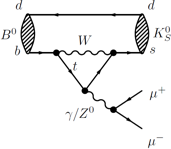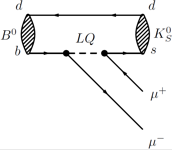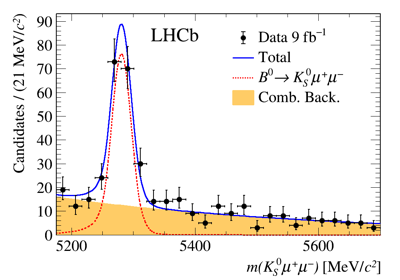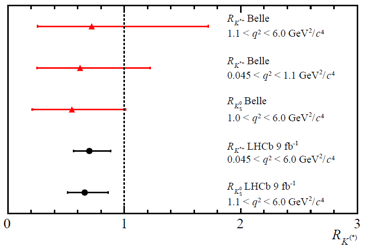Test of lepton universality using B0→KS0l+l– and B+→K*+l+l– decays.


Today at the CERN seminar and at the Rencontres de Blois the LHCb Collaboration presented new tests of lepton universality, one of the basic principles of the Standard Model (SM) of particle physics. This principle states that the SM treats the three charged leptons (electrons, muons and taus) identically, except for differences due to their different masses. The new measurements, while of limited statistical sensitivity, exhibit the same coherent pattern of deviations from lepton universality as seen in previous LHCb results.
In March 2021, the collaboration reported an evidence at 3.1 standard deviations (σ) for the breaking of lepton universality in a measurement of the ratio RK. Deviations at the level of 2.2-2.5 σ in a measurement of the ratio RK*0 were also reported in April 2017. The ratio RK describes how often a B+ meson decays to a charged kaon and either a positive and a negative charge muon (K+μ+μ–) or a positron-electron pair (K+e+e–). The ratio RK*0 is similar, only the meson K+ is replaced by a K*0 meson in the B meson decay. Both ratios exhibit a deficit of μ+μ– pairs with respect to e+e– pairs. Today’s results also report tests of lepton universality, using ratios RK and RK*. However, in this measurement, K and K* mesons with different electric charges have been used. Physicists call these newly measured decays the “isospin partners” of the previously measured decays. The new ratios are labelled RKS0 and RK*+.
LHCb has studied a number of other such ratios comparing decays with different leptons (l=e, μ, or τ leptons) in beauty particle decays (see R(D*), R(J/ψ) and R(pK)). These results revealed hints of deviations from lepton universality, none of which is significant enough to constitute an observation of new physics on its own. However, according to theorists who study possible extensions of the SM, these deviations combined suggest an interesting and coherent pattern, which could be evidence for physics beyond the SM.
The decays used to study lepton universality are extremely rare. They involve the transformation of a beauty quark into a strange quark (b→s), a process that is highly suppressed in the SM and can be affected by the existence of new particles. These not discovered particles could have masses too high to be produced directly at the Large Hadron Collider. The diagram to the left shows SM contributions to the B0→KS0l+l– decay, involving photons (γ), W, and Z0 bosons. The diagram to the right shows a possible new physics contribution to the decay from a hypothetical leptoquark (LQ) that, unlike the SM bosons, could have different interaction strengths with the different types of leptons. The measurements announced today are also expected to be affected by the same potential new physics contributions.
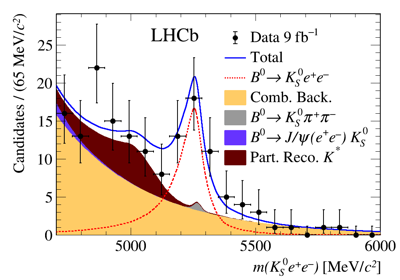
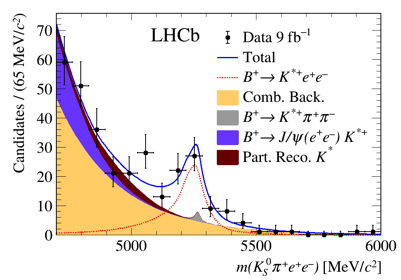
The top left image above shows the KS0μ+μ– mass distribution and the top right image the KS0e+e– mass used to determine the RKS0 ratio. The bottom left image shows the KS0π+ μ+μ– mass distribution and the bottom right the KS0π+e+e– mass distribution used to determine the RK*+ ratio. Note that a K*+ meson decays into a KS0 and a π+ meson and note also a clear accumulation of events at the B0 or B+ mass.
The values of the RKS0 and RK*+ ratios announced today are listed at the top of this article for different regions of the dilepton invariant mass squared, q2. They are individually consistent with the SM at the 1.4 and 1.5σ level, their combination at the 2σ level (for experts: using a fit for a single Wilson coefficient). It is interesting to note that the central values exhibit the same coherent pattern of deviation as the other lepton universality tests performed by LHCb – the muon pairs are observed less frequently than the electron pairs. The image to the left lists the new measurements by LHCb, the most precise to date, of RKS0 and RK*+ ratios, and previous measurments by Belle.
Read more in the LHCb presentations at CERN and at Blois, and in the LHCb paper and in the conversation article.

